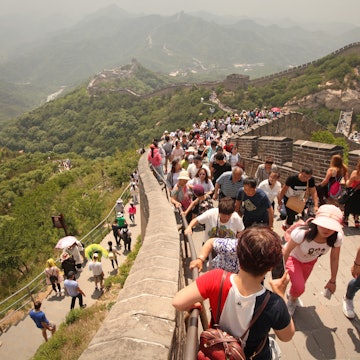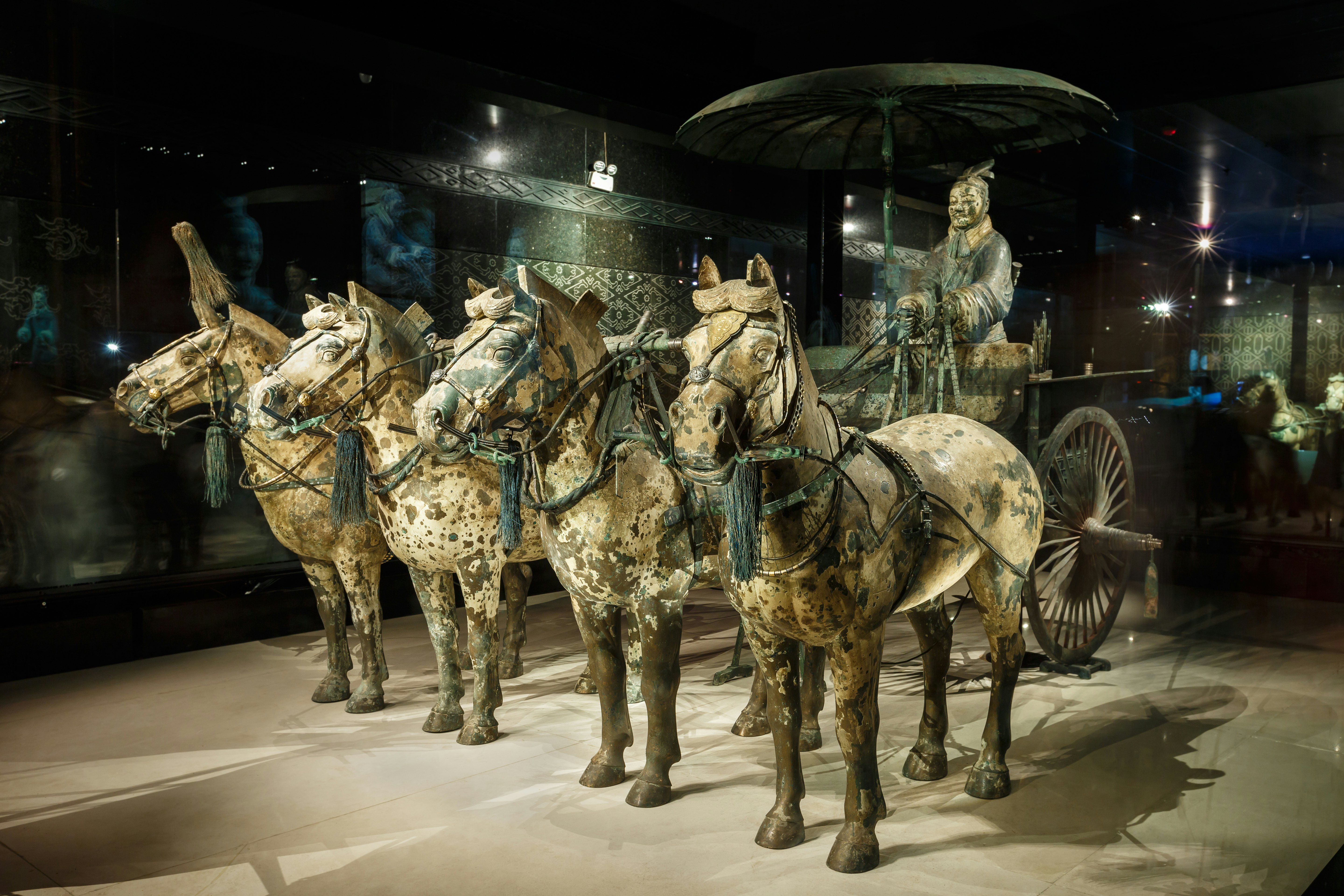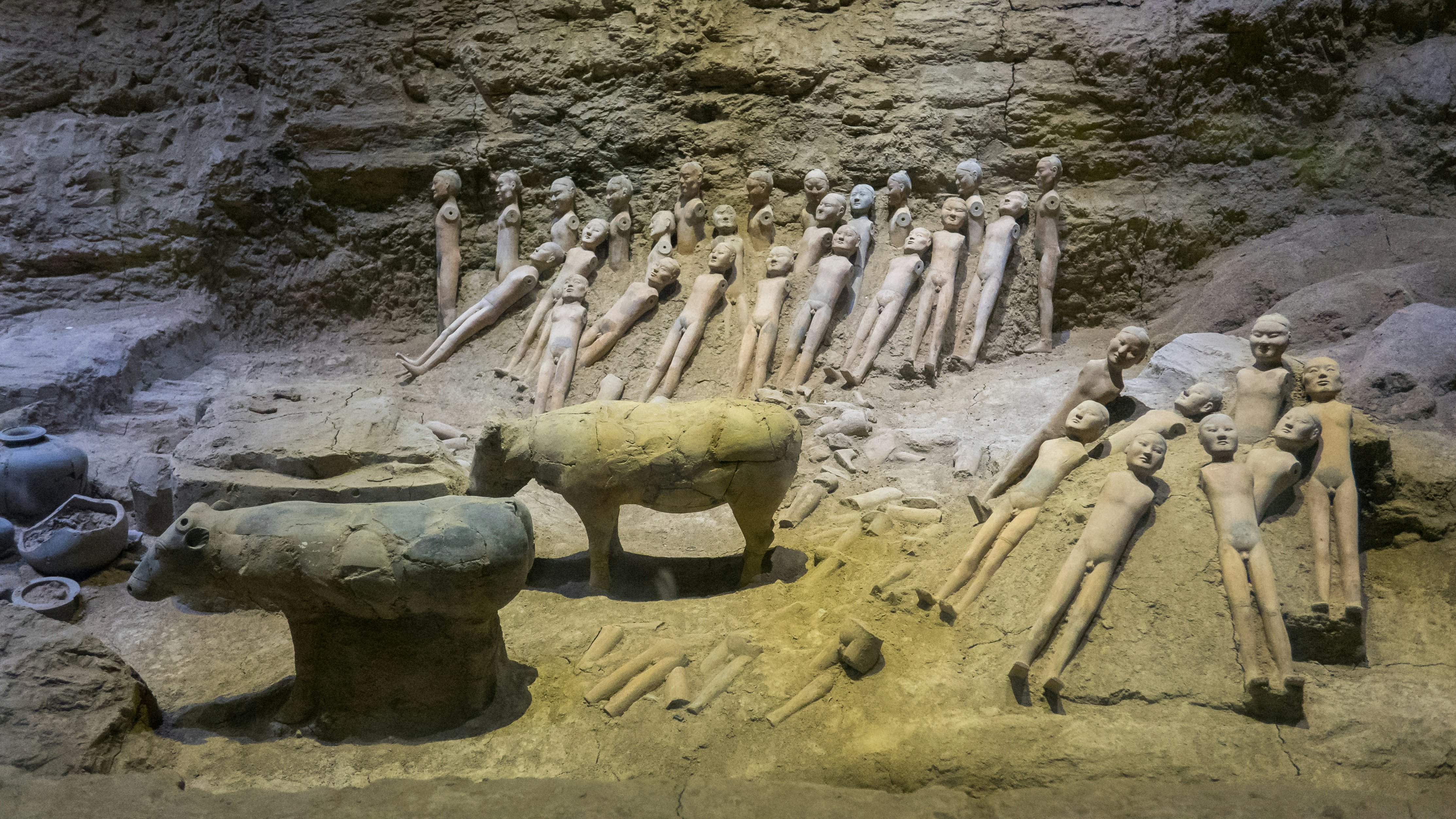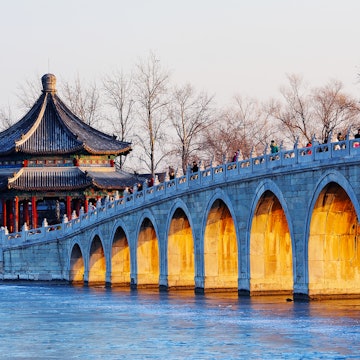
A guide to visiting China's Terracotta Warriors in Xi'an



The amassed soldiers of the Terracotta Army near Xi'an in China. DnDavis/Shutterstock
When it comes to heart-stopping sights, China has some of the best. Travelers can walk the Great Wall, cruise along the Yangzi River, explore the lonely fortresses and cave temples of the Silk Road, or wander the timeless precincts of the Forbidden City in Beijing. But even in this company, the Army of Terracotta Warriors in Xi’an stands out as something special.
One of the most famous archaeological finds in the world, this subterranean, life-size army of pottery soldiers has silently stood guard over the soul of the emperor who first unified China for more than two millennia. Part of the vast funerary complex of Emperor Qin Shi Huang (259–210 BCE), these ancient terracotta figures have endured the many changes of China’s long history in remarkably intact condition – not bad for a site as old as Ancient Rome!
Why were these clay regiments built? Well, either Qin Shi Huang was terrified of the vanquished spirits awaiting him in the afterlife or, as most archaeologists believe, he expected his rule to continue in death as it had in life, hence this formidable entourage.
Visiting the Terracotta Army is one of China’s most memorable travel experiences, and a reason to travel to Xi’an all by itself. Here’s everything you need to know about visiting the Army of Terracotta Warriors.

What’s the history of the Terracotta Army?
The discovery of this army of ceramic warriors was a case of pure luck. In 1974, local farmers drilling a well uncovered a vast underground vault. When the site was eventually excavated, archaeologists discovered thousands of terracotta soldiers and horses in what appeared to be a battle formation.
Since then, the site has become so famous that many of its unique features are well known around the globe – including the fact that each of these thousands of soldiers has a different face. To date, some 2000 warriors and horses have been carefully excavated and meticulously pieced back together, but this is still an active excavation site, with an estimated 6000 statues yet to be uncovered.
Together with other incredible finds from the 3rd-century-BCE mausoleum of Qin Shi Huang, the first emperor of China, these clay guardians offer remarkable insights into the cultural practices and technological advancement of ancient China. If you’ve only seen pictures or lone soldiers in touring exhibitions, the sight of the full army in situ will take your breath away.
When should I visit the Terracotta Army?
The complex comprising the Terracotta Warriors site and the Mausoleum of Qin Shi Huang is open from 8:30am to 4:30pm from November to March, and from 8:30am to 5pm from March to November. Last admission is an hour before closing. Try to visit earlier in the day – there’s a lot to see, particularly if you visit the other nearby tombs, and you don’t want to rush the experience.
The best time to visit Xi'an is during the spring (from April to May) or the fall (from September to October). Wandering around the mausoleum complex can be draining during the hot and often humid summer, and chilly during the mostly snow-free but cold winter.

How much time should I spend seeing the Terracotta Army?
Although you can explore the highlights in a few hours, there’s plenty here to keep you occupied for a full day – it’s a vast site, and your ticket covers entry to the Terracotta Army and the Mausoleum of Qin Shi Huang, about 1.5km west, where you can visit the superb Bronze Chariots Museum. A free shuttle bus runs to the mausoleum site from opposite the Terracotta Army’s ticket office, saving you a long walk. If you also plan to visit the royal tombs in the Han Yangling and Qian Mausoleum complexes, you'll definitely need at least a whole day.
What’s the best way to see the Terracotta Army?
Qin Shi Huang's mausoleum complex is about 40km from the center of Xi’an, so factor in the time it takes to get here (one hour) when you make your plan for the day. When you get to the pits, visit them in reverse order, starting with Pit 3 and building up to Pit 1 – the most impressive. Finish up by visiting the Mausoleum of Qin Shi Huang and the Bronze Chariots Museum.
Hiring a guide is worthwhile; the site’s audio guide is less useful. As you leave, you can pick up all manner of terracotta ornaments, from warrior paperweights to life-size reproduction terracotta soldiers, at the site’s souvenir shop.
How much do tickets cost?
Tickets to enter the Qin Shi Huang Mausoleum complex cost ¥120 for adults, allowing entry to the Terracotta Warriors site, the Mausoleum of Qin Shi Huang and the Bronze Chariots Museum. There are discounts for students, children and the elderly, and free entry for people with disabilities, though these reduced rates are generally intended for Chinese citizens with appropriate documentation. Guides and audio guides cost extra.
What should I eat and drink at the Terracotta Warriors complex?
There’s a cafe and a reasonably priced restaurant within the pits' enclosure, and a wider choice of places to eat as you walk back to the car park and bus stops. Carry water and snacks in case you get peckish as you wander around.
How do I get to the Terracotta Warriors?
The Terracotta Warriors complex lies just 40km (an hour) from Xi’an, and almost everyone visits from this historic city. Indeed, some travelers head to the Terracotta Warriors directly from the station (there’s luggage storage at the site).
You can get to the site conveniently by taxi, on a tour, or on board one of the air-conditioned buses (numbers 914 or 915) from Xi'an train station. A free bus shuttles ticket holders from the Terracotta Warriors site to the Mausoleum of Qin Shi Huang complex.
Getting to Xi’an is easy. Flights arrive at the city's busy airport from across China and from all over Asia. Xi'an is also on China’s high-speed rail network. Despite the considerable distances involved, you can reach Xi’an by train in less than six hours from Beijing or Shanghai.

What are the must-sees when you visit the Terracotta Warriors?
Beyond the burial pits at the Terracotta Warriors site, be sure to visit the Exhibition Hall to see more treasures from the excavations. You can visit the pits in any order, but perhaps the best approach is to go from Pit 3 to Pit 1, leaving the most impressive pit for a grand finale.
Pit 3
Discovered in 1976, U-shaped Pit 3 is the smallest of the clay army pits at 530 sq meters. From here, 68 human sculptures, four horse sculptures and the remains of a chariot have been excavated. It’s believed the pit was intended to represent the army headquarters, due to the number of figures of high-ranking officers unearthed here. The structure includes a special chamber to the north for making sacrificial offerings before battle.
Pit 2
This L-shaped pit, also discovered in 1976, contains around 1300 warriors and horses, but most of them are either in pieces or covered by centuries of mud awaiting excavation – you’ll likely see archaeologists at work as you circle the pit, meticulously extracting the pottery soldiers from their earthy tomb.
Off to the side of the building, in glass cases, you can examine five of the reconstructed soldiers – a kneeling archer, a standing archer, a cavalry soldier and his horse, a mid-ranking officer and a general – up close. The level of detail is extraordinary. The expressions, hairstyles, armor and even the tread on the footwear of each figure are unique.

Pit 1
Housed in a building the size of an aircraft hangar, Pit 1 was the first pit to be discovered and is the largest, at 62m wide and 230m long. It’s believed that the figures of some 6000 warriors and horses are buried here, of which around 1000 have been excavated. In this vast space, the full scale of the Terracotta Army becomes apparent.
A vanguard of three rows of archers is followed by the main force of foot soldiers, who originally held spears, swords, dagger-axes and other weapons. The infantry soldiers were accompanied by 35 chariots, though these, being made of wood, have long since disintegrated. Various items of weaponry, including bronze swords, spears, crossbows, arrows and billhooks, have been recovered from the site.
The Exhibition Hall
Before waving goodbye to the clay army, take a look at the site’s Exhibition Hall. Displays here focus in more detail on the warriors and the wider mausoleum site, with selected objects from the 50,000 or so cultural relics recovered here, including stone armor and elegant bronze statues of cranes. There is also a cinema showing an informative movie about the Terracotta Warriors, but at the time of writing, it was out of commission.

Mausoleum of Qin Shi Huang
About 1.5km west of the pits containing Qin Shi Huang’s legendary Terracotta Army lies the vast mausoleum of the man who ordered their creation. Originally covering more than 45 sq km on the slopes of Mt Lishan, this was one of the grandest necropolises in the world when it was created, and at its heart lies the emperor’s still unexcavated, 76m-tall burial mound, flanked by a peaceful park.
The construction of Qin Shi Huang’s tomb was a massive undertaking. Work on the complex began after Qin Shi Huang came to the throne in 246 BCE, but it was only finished during the reign of the second Qin emperor in 208 BCE. Some 700,000 skilled artisans and forced laborers were brought in to work on the mammoth memorial.
The emperor’s mound remains untouched partly to preserve the archaeological integrity of the site, but archaeologists are also cautious of entering the tomb because of the high levels of mercury contamination in the soil, suggesting that some of the legends about artificial rivers of mercury and ingenious traps surrounding the emperor’s final resting place may be true.
A city’s worth of effigies and items needed for the afterlife were buried around the site when Qin Shi Huang was placed inside his tomb. Some 600 different kinds of accessory pits have been discovered so far, and several can be visited within the mausoleum grounds. In Pit K9901, you can view some of the 20 restored figures of acrobatic performers found there, while Pit K0006 holds the remains of a dozen statues of court officials.
The complex is covered by the same ticket as for the Terracotta Warriors, and it’s a sprawling site. It’s worth paying the extra ¥15 to use the electric cart transporting visitors to the pits and museum from the entrance.
Bronze Chariots Museum
The most important find from the mausoleum site is displayed in the vast underground Bronze Chariots Museum, set within the mausoleum complex. In 1980, just 20m west of the imperial tomb, archaeologists unearthed a pair of half-life-size bronze chariots, together with their drivers and teams of horses. It’s believed they were intended as vehicles for inspection tours of the emperor’s tomb in the afterlife.
It took 8 years for the 3000 pieces of these beautiful decorative sculptures to be reassembled, and the museum that displays them does a splendid job, offering close-up views of these ancient treasures, which are exact replicas of real life down to the finest detail.

Other burial sites around Xi'an
More fascinating funerary sites lie dotted around Xi’an. About half an hour north of the city by the Wei River, the Han Yangling National Archaeological Site Park is the burial place of Emperor Jingdi (188–141 BCE) of the Han dynasty, and his wife, Empress Wang Zhi. Comprising two large burial mounds, over 130 attendant tombs, the ruins of the town of Yangling and even a graveyard for prisoners who died while constructing the mausoleum, it's the most intact Western Han dynasty imperial tomb so far uncovered.
The contents of the emperor’s tomb paint a vivid picture of ancient imperial life. Influenced by Taoist precepts, Jingdi took many steps to improve the lives of his subjects. He lowered taxes greatly, used diplomacy to cut back on unnecessary military expeditions, and even reduced the severity of the often brutal punishments handed out to criminals.
In the excavation area, glass floors allow you to peer directly into the narrow burial pits and walk over the top of ongoing excavations. So far, over 50,000 miniature terracotta figures have been uncovered here. The site museum displays the best of these expressive terracotta figurines, including eunuchs, servants, domesticated animals and even female cavalry on horseback. The doll-like figurines originally had movable wooden arms, but these have long since rotted away.

The highlight of the sprawling Qianling Scenic Area, about 85km northwest of Xi’an, is the Qian Mausoleum, the final resting place of Empress Wu Zetian, who is buried on Mt Liang with her husband, Emperor Gaozong, whom she succeeded. Their tombs, which lie deep inside the mountain beneath memorial towers, remain unexcavated. However, the approach up the slopes of Mt Liang is highly impressive.
The long and broad Spirit Way is lined with enormous, lichen-encrusted sculptures of animals, mythical creatures and officers of the imperial guard. It culminates with 61 headless statues of foreign diplomats and leaders from different Chinese ethnic groups who attended the emperor’s funeral. If you don't feel up to the long walk to the mausoleums from the visitor center, there's a shuttle service.
Is the Terracotta Army accessible?
This is one of China’s most popular sights, and it’s highly accessible. Paths around the site are flat and wheelchair friendly and ramps provide access to the pits, which are also partly wheelchair accessible. There are free wheelchairs available for loan, on a first-come, first-served basis. The site officially offers free entry to disabled visitors, but this may only be granted to Chinese citizens.
This article was adapted from Lonely Planet’s China guidebook, published in August 2025.













